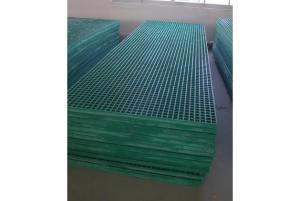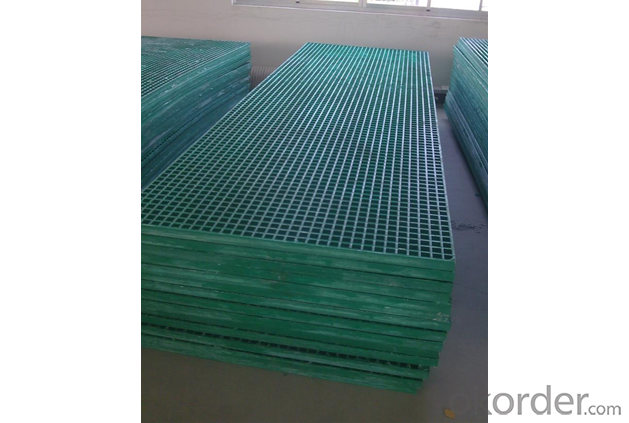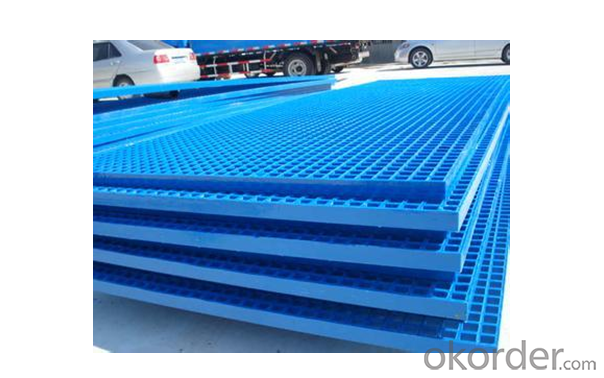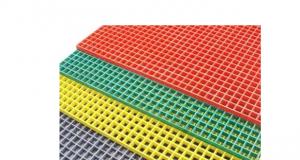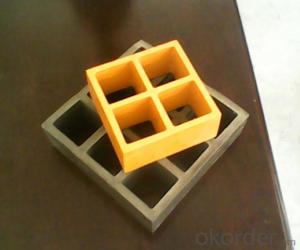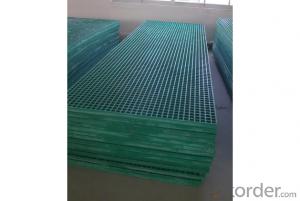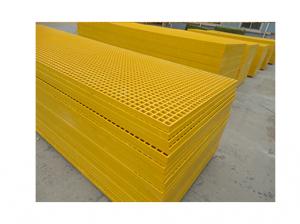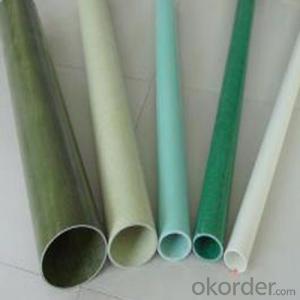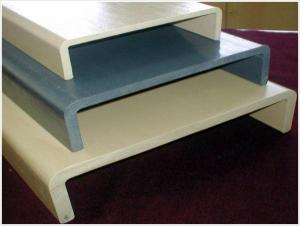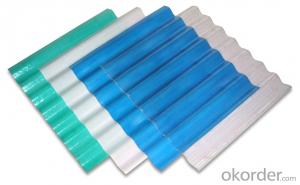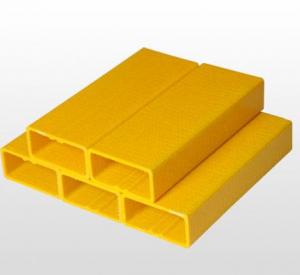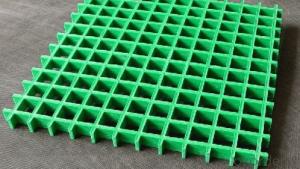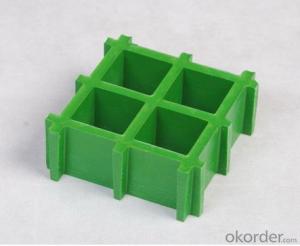FRP Pultrusion Profiles - FRP Gratings, Molded Gratings, and Modern Shape Fiberglass Plastic Walkway Grating
- Loading Port:
- China main port
- Payment Terms:
- TT or LC
- Min Order Qty:
- 100 m²
- Supply Capability:
- 500000 m²/month
OKorder Service Pledge
OKorder Financial Service
You Might Also Like
Introduction
FRP Molded Grating is a structural panel which uses high-strength E-Glass roving as reinforcing material, thermosetting resin as matrix and then casted and formed in a special metal mold. It provides properties of light weight, high strength, corrosion resistance, fire resistance and anti-skid. FRP Molded Grating is widely used in oil industry, power engineering, water & waste water treatment, ocean survey as working floor, stair tread, trench cover, etc. and is an ideal loading frame for corrosion circumstances.
Feature
Corrosion Resistance
Fire Resistance
- Electrical Insulating
Aging Resistance
Specification
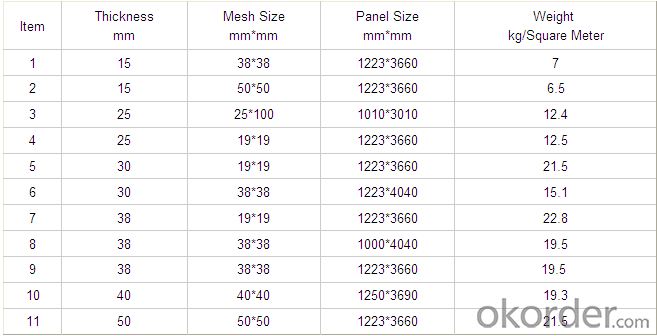
Advantage
coated with prevent aging layer
excellent insulating performance
no maintenance
- easy installation
Application
Power plants, substation equipment enclosures, antimagnetic, anti-static,to prevent small animals into the equipment failure, as there is electricity facilities and without power interval intervals.
- Pool railings in sewage treatment industry
Corrosive chemical industry equipment around the fence
All kinds of building maintenance section
FAQ
1. How about the documents after shipment?
After shipment, we ll send all original documents to you by DHL, including Packing List.Commercial Invoice, B/L, and other certificates as required by clients.
2. How long is the delivery time?
Usually it takes 10-25days after receipt of the deposits or L/C, and it also depends on the quantity of your order.
PROCESS
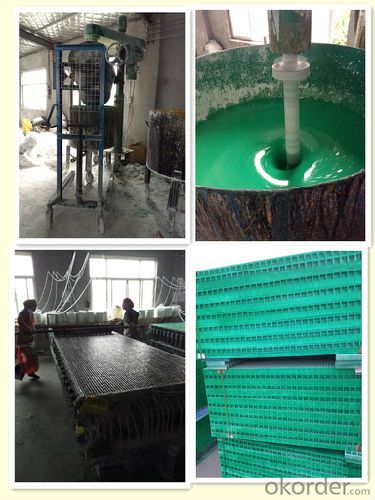
FACTORY
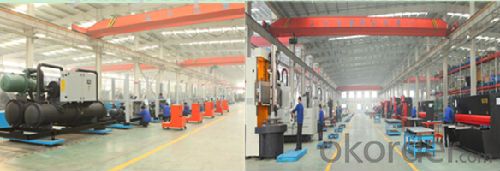

- Q: Can FRP pultrusion profiles be used in the construction of railway sleepers?
- The use of FRP (Fiber Reinforced Polymer) pultrusion profiles is indeed possible in the construction of railway sleepers. These profiles possess a range of advantages that render them suitable for this particular application. To begin with, the lightweight yet robust nature of FRP pultrusion profiles makes them an ideal option for railway sleepers. They boast high strength-to-weight ratios, enabling them to withstand heavy loads and reliably support the weight of trains. Moreover, their lightweight constitution facilitates transportation and installation, thereby reducing construction time and costs. Additionally, FRP pultrusion profiles exhibit a high resistance to corrosion, a crucial aspect for railway sleepers. Unlike traditional materials such as wood or steel that are prone to corrosion when exposed to moisture and chemicals, FRP profiles are non-corrosive. Consequently, they do not necessitate regular maintenance or replacement due to rust or decay. Furthermore, these profiles offer exceptional durability and longevity. They can withstand UV radiation, extreme temperatures, and chemicals, ensuring a longer lifespan compared to conventional materials. As a result, the need for frequent replacements is minimized, leading to reduced maintenance and lifecycle costs. Moreover, FRP pultrusion profiles can be tailored to meet specific design requirements. They can be manufactured in various shapes and sizes to accommodate different railway sleeper designs, providing flexibility in construction. Additionally, they can be produced in different colors, allowing for aesthetic customization. Lastly, FRP pultrusion profiles possess excellent electrical insulation properties, a critical factor for railway sleepers. They are capable of providing insulation between the train tracks and the ground, preventing electrical interference and ensuring safe operation. In conclusion, FRP pultrusion profiles are a suitable choice for constructing railway sleepers due to their lightweight yet strong composition, corrosion resistance, durability, customization options, and electrical insulation properties.
- Q: Can FRP pultrusion profiles be used in agricultural applications?
- Indeed, FRP pultrusion profiles are applicable in the field of agriculture. Renowned for their remarkable strength-to-weight ratio, resistance to corrosion, and durability, FRP pultrusion profiles are an ideal choice for a variety of agricultural uses. One common utilization of FRP pultrusion profiles in agriculture is the construction of livestock enclosures, encompassing fences, gates, and pens. These profiles possess outstanding resistance to weather conditions, chemicals, and degradation caused by UV rays, ensuring their long-lasting performance in outdoor environments. Furthermore, their lightweight composition facilitates ease of handling and installation. Moreover, FRP pultrusion profiles find application in the production of agricultural equipment and machinery. They can be employed for structural components, such as beams and supports, as well as functional parts like handles, brackets, and covers. The impressive strength of FRP profiles enables them to withstand heavy loads and challenging operating conditions, while their resistance to corrosion guarantees their longevity in corrosive surroundings such as fertilizer storage areas or livestock waste management systems. Additionally, FRP pultrusion profiles can be utilized for irrigation systems in agriculture. Their non-conductive nature renders them perfect for situations requiring electrical insulation, such as the creation of irrigation pipes or channels. Furthermore, the corrosion resistance of FRP profiles ensures their ability to endure exposure to water, chemicals, and fertilizers frequently employed in agricultural irrigation. To summarize, FRP pultrusion profiles exhibit exceptional suitability for agricultural applications due to their high strength, resistance to corrosion, and durability. Whether employed in livestock enclosures, agricultural machinery, or irrigation systems, FRP profiles offer numerous advantages that position them as a reliable choice within the agricultural industry.
- Q: Are FRP pultrusion profiles resistant to chemicals used in pharmaceutical packaging?
- Yes, FRP pultrusion profiles are highly resistant to chemicals used in pharmaceutical packaging. The unique properties of fiberglass reinforced plastic, such as its corrosion resistance and non-reactivity to most chemicals, make FRP pultrusion profiles an ideal choice for pharmaceutical packaging applications.
- Q: Are FRP pultrusion profiles resistant to chemicals used in agricultural applications?
- Yes, FRP (Fiber Reinforced Polymer) pultrusion profiles are highly resistant to chemicals used in agricultural applications. FRP pultrusion profiles are made from a combination of reinforced fibers and a polymer resin matrix, typically polyester or vinyl ester. These materials provide excellent resistance to a wide range of chemicals commonly used in agriculture, such as fertilizers, pesticides, herbicides, and various acids. The inherent corrosion resistance of FRP pultrusion profiles makes them a preferred choice in agricultural applications where exposure to chemicals is common. Unlike traditional materials like wood, steel, or concrete, FRP profiles do not deteriorate or degrade when exposed to aggressive chemicals. This resistance ensures that the profiles maintain their structural integrity and performance over a long lifespan, even under harsh agricultural conditions. Furthermore, FRP pultrusion profiles offer superior resistance to corrosion, moisture, UV radiation, and temperature fluctuations. These properties make them highly durable and suitable for a wide range of agricultural applications, including structural supports, fencing, grating, decking, and irrigation systems. It is important to note that while FRP pultrusion profiles are highly resistant to chemicals, they may still experience some level of degradation or staining when exposed to extremely concentrated or highly aggressive chemicals. Therefore, it is recommended to consult with the manufacturer or supplier to ensure that the specific chemicals used in the agricultural application are compatible with the chosen FRP pultrusion profiles.
- Q: Are FRP pultrusion profiles resistant to caustic soda?
- FRP pultrusion profiles are generally immune to caustic soda, which is a potent alkaline substance capable of corroding certain materials. However, FRP pultrusion profiles consist of robust fibers (like fiberglass) combined with a resin matrix (such as polyester or epoxy). This composite construction renders them highly resistant to chemicals, including caustic soda. Consequently, FRP pultrusion profiles find extensive application in industries prone to exposure to corrosive substances, such as chemical processing, wastewater treatment, and mining. It is worth noting that the choice of resin in the FRP profiles, along with the concentration and temperature of the caustic soda, can impact the overall level of resistance.
- Q: Are FRP pultrusion profiles electrically conductive?
- No, FRP pultrusion profiles are not electrically conductive.
- Q: How to install GRP mark pile
- The life of the font (because the FRP material should be polished and polished before printing, so that the printed fonts can be longer and a little bit less concrete)
- Q: Can FRP pultrusion profiles be used in the automotive manufacturing industry?
- Yes, FRP pultrusion profiles can be used in the automotive manufacturing industry. They offer several advantages such as high strength-to-weight ratio, corrosion resistance, and design flexibility. These profiles can be used in various automotive applications including body panels, structural components, and interior trim.
- Q: Are FRP pultrusion profiles resistant to moisture?
- Yes, FRP pultrusion profiles are highly resistant to moisture due to the inherent properties of fiberglass and the resin matrix used in their production. This resistance makes them an excellent choice for applications where moisture exposure is a concern, such as outdoor structures, marine environments, and infrastructure exposed to wet conditions.
- Q: Can FRP pultrusion profiles be used in the construction of shipping containers?
- Indeed, the utilization of FRP pultrusion profiles in the construction of shipping containers is possible. These profiles offer numerous advantages that render them suitable for this purpose. To begin with, FRP pultrusion profiles possess exceptional strength and durability. They exhibit a high strength-to-weight ratio, enabling the creation of lightweight shipping containers capable of withstanding heavy loads and harsh environmental conditions. This characteristic proves particularly advantageous in the shipping industry, where containers endure rough handling and extreme weather while in transit. Furthermore, FRP pultrusion profiles display resistance to corrosion, a significant concern in the shipping industry due to exposure to saltwater and other corrosive substances. Unlike traditional materials like steel, FRP does not rust or corrode, thereby ensuring a longer lifespan for the shipping containers. Moreover, FRP pultrusion profiles exhibit excellent thermal insulation properties. This characteristic facilitates the maintenance of a consistent temperature within the shipping containers, which is crucial for transporting temperature-sensitive goods such as food, pharmaceuticals, and chemicals. Additionally, FRP pultrusion profiles can be easily customized and fabricated into various shapes and sizes, allowing for design flexibility in the construction of shipping containers. They can be molded to specific dimensions and incorporate features such as reinforcements, fastening points, and integrated insulation. Notably, FRP pultrusion profiles are also non-conductive and possess low thermal conductivity. These attributes make them an ideal choice for shipping containers that transport sensitive electronic equipment or hazardous materials, as they reduce the risk of electrical and thermal accidents. In conclusion, FRP pultrusion profiles can indeed be employed in the construction of shipping containers. Their strength, durability, corrosion resistance, thermal insulation properties, design flexibility, and non-conductive nature make them a reliable and practical choice for this application.
Send your message to us
FRP Pultrusion Profiles - FRP Gratings, Molded Gratings, and Modern Shape Fiberglass Plastic Walkway Grating
- Loading Port:
- China main port
- Payment Terms:
- TT or LC
- Min Order Qty:
- 100 m²
- Supply Capability:
- 500000 m²/month
OKorder Service Pledge
OKorder Financial Service
Similar products
Hot products
Hot Searches
Related keywords
